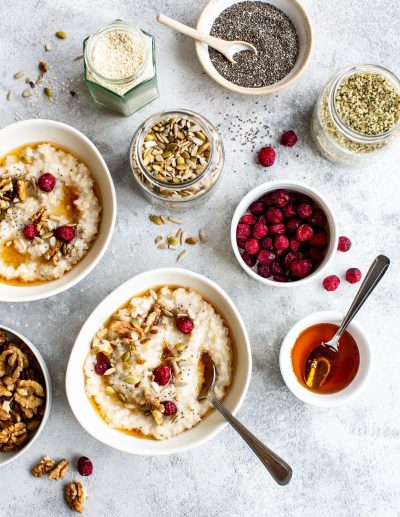The Amazing Power of Wholegrains!

The Amazing Power of Wholegrains!
The most important dietary change you can make is to integrate whole cereal grains (particularly short-grain brown rice) into your daily diet. This should be a staple for everyone. Simply put, whole grains and grain products are the cornerstones of any healthy, whole foods diet.
We can supplement whole grains with fresh fruits and vegetables from land and sea, as well as beans, nuts, and seeds. With the abundant variety of grains available to us, it's one of the world's most nutritious foods. Grains are the link between the plant and animal kingdom from which we, as humans, draw life. Of the three macronutrients (carbohydrates, protein and fat), carbohydrates are needed in the largest amounts. Here are seven reasons complex carbohydrates have such superstar status.
They are the main source of fuel for your body. They are burned most efficiently as a fuel source. They are required by your central nervous system, brain (your brain runs almost entirely on glucose and can’t use fat or protein for its energy needs), muscles (including your heart), and kidneys. They provide glucose to all of your body’s cells and tissues for energy. They can be stored in your liver and muscles for future energy needs. They can be found in whole grains, grain products, beans, vegetables, sea vegetables, fruits, nuts and seeds. Whole-grain foods support good health.
Eating whole grain foods reduces the risk of digestive disorders, heart disease, high cholesterol, high blood pressure, type 2 diabetes, obesity and certain cancers. Whole grains are high in complex carbohydrates and fibre that help fill us up and delay hunger. Weight control is made easier by eating whole grains instead of higher-calorie foods. Grains are the seeds of plants, and whole-grain foods include all three parts:
Composition and Nutrition
Bran – forms the outer layer of the seed and contains fibre, B vitamins, minerals (magnesium, phosphorus, iron, zinc, selenium, copper) and phytochemicals;
Endosperm – is the kernel and bulk of the seed containing complex carbohydrates, protein and B vitamins;
Germ – produces the sprout and contains B vitamins (niacin, thiamin, and riboflavin), vitamin E, minerals, unsaturated fats, phytochemicals and antioxidants.
Other nutrients in whole grains include tocopherols, beta-carotene, vitamin C, folate, glutamine, phytoestrogens, lignans, flavonoids, oligosaccharides, inositol, phenolics, saponins, lectins, and protease and amylase inhibitors. These nutrients may prevent diseases, lower blood cholesterol, stabilise blood sugar, and improve immune function.
Fibre is the part of plant-based foods that the body does not digest. Whole grains have both soluble and insoluble fibre. Oats, barley, and rye have soluble fibre that slows stomach emptying and nutrient absorption, reducing the rise in glucose and insulin to improve blood sugar control. Bran has insoluble fibre that adds bulk to stool and shortens transit time through the colon, reducing the time the bowels carry waste products.
Wholegrains are indispensable to health by regulating bowel function, stabilising blood sugar, discharging toxins, and decreasing cravings for sugar and fat.
A note on fibre: Dietary fibre from whole grains is divided into two groups, insoluble and soluble fibre. Both bind with the body’s harmful toxins, cholesterol, and fat (from which oestrogens are made) to remove them from our system via the bowel. Removing excess fat before it enters the bloodstream keeps oestrogen formation low. This is a positive quality because oestrogens can stimulate the growth of abnormal cells, which eventually leads to the growth of cancer cells. Known cancers that are stimulated to grow from oestrogen excess are breast, uterine, fallopian tube, vagina, prostate and ovarian, as well as head and neck cancers.
Pressure-Cooked Short Grain Brown Rice
Marlene's Power-Packed Nutritional Breakfast
Take two cups of rice, place them in a sieve and rinse well with water. Soak the rice overnight. Discard the soaking water and place in a pressure cooker. Add 4 cups of water to the rice and a pinch of sea salt. Seal the pressure cooker and bring to full pressure over the heat, then reduce to a low simmer for 25 minutes. Remove from the heat and allow the pressure to be released naturally for about 25 minutes. Remove the lid and hey presto!!….. You now have perfectly cooked whole grains.
You can use this batch of rice for your morning porridge just as I do and have done for decades. Simply warm the required amount of rice in a pan on the stove by adding some water, rice or oat milk and simmer for 5 or 10 minutes until creamy. For a sweet taste, add some dried fruit, chia seeds, nuts, shelled hemp seeds, ground flaxseed or linseed. If you prefer a salty taste, add a small drop of shoyu or tamari (naturally fermented soy sauces), some ground seeds, pumpkin seeds, sesame seeds, gomashio or sunflower seeds.
Alternatively, use the leftover rice by adding it to stir-fried vegetables, breaking up clumps of rice with the edge of a wooden spoon once you have added it to whatever you are cooking or make grain burgers.
I store my rice in a glass container for up to five days in the refrigerator and use it as I need it. If you do not have a pressure cooker, follow the instructions above, bring the rice to a boil and then simmer at a low heat until the water is absorbed and the rice is slightly sticky.
In good health
Marlene x

